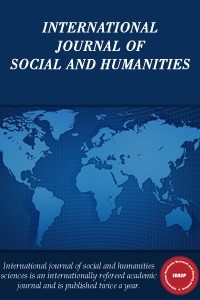KIRGIZİSTAN’DA OKLOKRASİ’NİN EVRİMLEŞMESİ
Oklokrasi, Demokrasi, Kırgızistan, Lale Devrimi, Akayev, Bakiyev, Ceenbakov, Caparov
EVOLUTION OF OCHLOCRACY IN KYRGYZSTAN
Ochlocracy, Democracy, Kyrgyzstan, Tulip Revolution, Akayev, Bakiyev, Jeenbakov, Japarov,
___
- Al Jazeera (2021). Kyrgyzstan’s Sadyr Japarov: From a prison cell to the presidency. https://www.aljazeera.com/features/2021/1/12/sadyr-japarov-from-a-prison-cell-to-the-presidency (accessed 04 December 2022).
- BBC (2014). Kyrgyzstan profile - Leaders President: Almazbek Atamba-yev. https://www.bbc.com/news/world-asia-16187957 (accessed 30 November 2022).
- Berdikeeva, Saltanat (2006). National Identity in Kyrgyzstan: the Case of Clan Politics. New York: Eurasia 21.
- Bertelsmann Stiftung. (2016). BTI 2016 Country Report Kyrgyzstan. Gütersloh: Bertelsmann Stiftung.
- Bertelsmann Stiftung (2020). BTI 2020 Country Report Kyrgyzstan. Gü-tersloh: Bertelsmann Stiftung.
- Bunce, Valere, Jay and Sharon L. Wolchik (2011). Defeating Authorita-rian Leaders in Postcommunist Countries. New York: Cambridge University Press.
- Chayes, Sarah (2016). The Structure of Corruption in Kyrgyzstan. https://carnegieendowment.org/files/9_Kyrgyzstan_Full_Web1.pdf (accessed 30 November 2022).
- Cicero (2008). De Re Publica. Cambridge: Cambridge University Press.
- Country Watch (2020). Kyrgyzstan Country Review. Houston: Country Watch.
- Engvall, Johan (2007). Kyrgyzstan: Anatomy of a State. Problems of Post-Communism 54(4), 33–45.
- Eshaliyeva, Kamila (2019). In Kyrgyzstan, the standoff between the old regime and the new authorities reaches new heights. https://www.opendemocracy.net/en/odr/kyrgyzstan-president-immunity-standoff/ (accessed 31 October 2022).
- European Parliament (2020). Another revolution in Kyrgyzstan?. https://www.europarl.europa.eu/RegData/etudes/ATAG/2020/659300/EPRS_ATA(2020)659300_EN.pdf (accessed 30 November 2022).
- Furstenberg, Saipira and Gulzat Botoeva (2020). Political unrest in Kyrgyzstan: between old and new hopes. https://fpc.org.uk/political-unrest-in-kyrgyzstan-between-old-and-new-hopes/ (accessed: 20 October 2022).
- Harwell, Drew et al. (13 January 2021). QAnon reshaped Trump’s party and radicalized believers. The Capitol siege may just be the start. https://www.washingtonpost.com/technology/2021/01/13/qanon-capitol-siege-trump/ (accessed 30 November 2022).
- Hasanovic, Jasmin (2015). Ochlocracy in the Practices of Civil Society: A Threat for Democracy?. Studia Juridica Et Politica Jaurinensin, 56–72.
- Ibraev, Omurbek (2016). Cost of Politics in Kyrgyzstan. London: West-minister Foundation of Democracy.
- Ismailbekova, Aksana (2018). Mapping Lineage Leadership in Kyrgyzs-tan: Lineage Associations and Informal Governance. Zeitschrift Für Ethnologie, 143, 195–220.
- Kamitake, Yoshiro (2007). From Democracy to Ochlocracy. Hitotsubas-hi Journal of Economics, 48, 83–93.
- Kaye, Josie Lianna (2018). Kyrgyzstan 2010-17. United Nations Univer-sity. https://i.unu.edu/media/cpr.unu.edu/attachment/2853/RC-Project-Kyrgyzstan.pdf (accessed 26 December 2022).
- Kennedy, Ryan (2014). Fading Colours? A Synthetic Comparative Case Study of the Impact of "Colour Revolutions". Comparative Politics, 46, 273–292.
- Kyrgyzstan Inquiry Commission. (2010). "Report of the Independent In-ternational Commission of Inquiry into the Events in Southern Kyrgyzstan in June 2020". https:/b/reliefweb.int/sites/reliefweb.int/files/resources/Full_Report_490.pdf (ac-cessed: 29 October 2022).
- Lang, Andrew, F. (19 January 2021). Hamilton and Lincoln warned of a mobocracy. Trump brought their fears to life. https://www.washingtonpost.com/outlook/2021/01/19/hamilton-lincoln-warned-mobocracy-trump-brought-their-fears-life/ (accessed 21 December 2022).
- Lincoln, Abraham (1837). Opposition to Mob-Rule. https://www.gutenberg.org/files/2653/2653-h/2653-h.htm#link2H_4_0018 (ac-cessed 21 December 2022).
- Madame Chiang Kai-Shek (1943). "The “Rule of Law” Democracy vs. Ochlocracy. Vital Speeches of the Day, 547–549.
- Madison, James (1787). Federalist No.10 The Same Subject Continued: The Union as a Safeguard Against Domestic Faction and Insurrection. https://guides.loc.gov/federalist-papers/text-1-10#s-lg-box-wrapper-25493273 (accessed 21 December 2022).
- Marat, Erica (2006). The Tulip Revolution: Kyrgyzstan One Year After. Washington D.C.: The Jamestown Foundation.
- Marat, Erica (2008). National Ideology and State-Building in Kyrgyzstan and Tajikistan. Washington D.C.: Central Asia-Caucasus Institute & Silk Road Studies Program.
- Marat, Erica (2012). Kyrgyzstan: A Parliamentary System Based On In-ter-Elite Consensus. Demokratizatsiya, 325–345.
- Nichol, Jim (2010). The April 2010 Coup in Kyrgyzstan and its After-math: Context and Implications for U.S. Interests. https://fas.org/sgp/crs/row/R41178.pdf (accessed 26 October 2022).
- Nogoibaeva, Elmira (2018). Anniversary of Jeenbekov’s Reign: The Main Dilemmas of the President. https://cabar.asia/en/anniversary-of-jeenbekov-s-reign-the-main-dilemmas-of-the-president (accessed 01 December 2022).
- Olcott, Martha Brill (2010). Instability in Krgyzstan: The International Response. https://carnegieendowment.org/files/0727_testimony_olcott.pdf (ac-cessed 29 November 2022).
- Polybius. (1979). The Histories III. Princeton and London: Harvard University Press and William Heinemann Ltd.
- Radnitz, Scott (2005). Networks, localism and mobilization in Aksy, Kyrgyzstan. Central Asian Survey, 24(4), 405–424.
- Radnitz, Scott (2006). What really happened in Kyrgyzstan. Journal of Democracy, 13(2), 132–146.
- Radnitz, Scott (2010). Weapons of the Wealthy Predatory Regimes and Elite-led Protests in Central Asia. Ithaca and London: Cornell University Press.
- Rezvani, Babak (2013). Understanding and Explaining the Kyrgyz–Uzbek Interethnic Confl ict in Southern Kyrgyzstan. Anthropology of the Midd-le East, 8(2), 60–81.
- Sarı, Yaşar (2010). Kırgızistan’da İktidarın El Değiştirmesi: Akayev ve Bakiyev’in Düşüşü. Orta Asya ve Kafkasya Araştırmaları 5(9), 27–47.
- Schmitz, Andrea (2021). Revolution Again in Kyrgyzstan: Forward to the Past?. https://www.swp-ber-lin.org/fileadmin/contents/products/comments/2021C08_RevolutionKyrgyzstan.pdf (accessed 01 December 2022).
- Sinnott, Peter (2007). Kyrgyzstan: A Political Overview. American Fore-ign Policy Interests, 29, 427–436.
- Soltobaev, Aziz (2005). New Authorities Blame Akayev’s Rule for Eco-nomic Downfall and Corruption. https://www.cacianalyst.org/publications/field-reports/item/9918-field-reports-caci-analyst-2005-5-4-art-9918.html?tmpl=component&print=1 (accessed 21 October 2022).
- Tudoroiu, Theodor (2007). Rose, Orange, and Tulip: The Failed Post-Soviet Revolutions. Communist & Post-Communist Studies, 40, 315–342.
- Umarov, Temur (26 October 2020). Who’s In Charge Following Revo-lution in Kyrgyzstan? https://www.themoscowtimes.com/2020/10/26/whos-in-charge-following-revolution-in-kyrgyzstan-a71856 (accessed 02 December 2022).
- U.S. Embassy in the Kyrgyz Republic (2021). U.S. Embassy Statement on Kamchybek Kolbaev’s Release. https://kg.usembassy.gov/u-s-embassy-statement-on-kamchybek-kolbaevs-release/ (accessed 02 December 2022).
- Wlodek, Ludwika (2020). Clan war instead of fighting coronavirus and corruption. Opinion and Analysis, 109–114.
- ISSN: 2602-3288
- Başlangıç: 2017
- Yayıncı: Tuncay AYDEMİR
REFLEXES OF TURKISH CONSTRUCTION INDUSTRY AGAINST FINANCIAL CRISES AND MORTGAGE
Ömer Emre KARAASLAN, Uğur ÖZCAN
TOPLUMSAL CİNSİYET VE MADEN MÜHENDİSİ OLMAK: TÜRKİYE ÖRNEĞİ
Mustafa KARA, Tugba Deniz TOMBAL KARA
PSYCHOLOGICAL WELL-BEING AMONG FEMALE EMERGING ADULTS AS A FUNCTION OF PARENTAL AUTONOMY SUPPORT
Ryan Macey WİSE, Aylin ERBAHAR, Ilayda AKINKOÇ
Nuran ÇAKIR YILDIZ, Özlem KARAMAN
TRADE BALANCE AND UNEMPLOYMENT IN EURO REGION: A VECTOR ERROR CORRECTION MODEL APPROACH
Osama SHAİKH, Zubair Arif SHAH
ELEŞTİREL JEOPOLİTİĞİN BİR BOYUTU OLARAK FEMİNİZM JEOPOLİTİK
Saba TAGHİ BONYAD, Shalaleh ZABARDASTALAMDARİ
JEOMORFOLOJİ-HİDROGRAFYA BAĞLAMINDA BİR ALAN İNCELEMESİ: YUKARI KARASU HAVZASI ÖRNEĞİ
Mehmet Akif SEYİTOĞULLARI, Ali Fuat DOĞU, Bülent MATPAY
KIRGIZİSTAN’DA OKLOKRASİ’NİN EVRİMLEŞMESİ
ÇAĞDAŞ KONUT MİMARİSİNDE GELENEKSEL MALZEME VE YAPIM TEKNİKLERİNİN BALKON ÜZERİNDEN İNCELENMESİ
